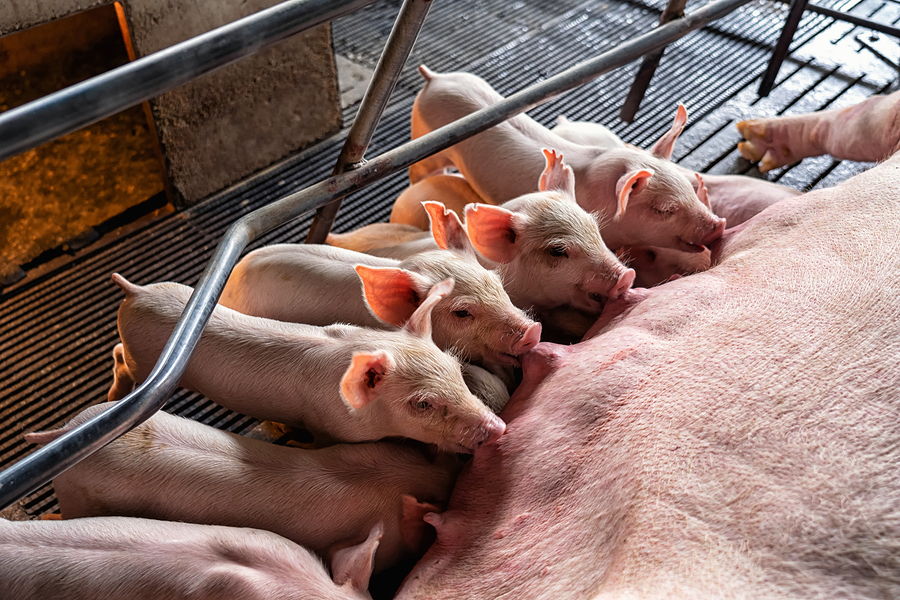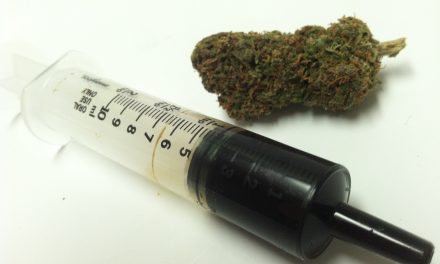A controversial drug allowed in meat production in the U.S.—but banned in 160 other countries—is in the news again. This time, it’s because the Trump administration, as part of a trade deal, is trying to force China to allow imports of U.S. pork raised with ractopamine.
RELATED STORY:
Ractopamine is a beta-agonist routinely fed to pigs, cattle and turkey raised in industrial factory farms, or in industry parlance, “concentrated animal feeding farms,” or CAFOs. The drug mimics the effects of adrenaline, and is used to increase muscle tissue and make animals grow faster. It’s manufactured by Elanco Animal Health, until recently a division of drug giant Eli Lilly & Co.
If you buy industrially produced pork at a U.S. supermarket, it likely contains ractopamine—about 60 – 80 percent of industrial pork producers use the drug. If Trump forces China to allow imports of U.S. pork raised with ractopamine, that percentage could increase—and so will Elanco’s profits.
Pork producers aren’t required to tell you they use ractopamine, so don’t bother looking for it on the label. To avoid it, buy from a trusted local farmer, or look for the American Grassfed Association (AGA) logo—AGA-certified meat prohibits the use of ractopamine.
RELATED STORY:
Ractopamine’s long, controversial history
In 2013, the Center for Food Safety (CFS) and Animal Legal Defense Fund (ALDF) sued the U.S. Food & Drug Administration (FDA) for withholding records pertaining to ractopamine’s safety.
According to the lawsuit, in response to the groups’ requests for information “documenting, analyzing or otherwise discussing the physiological, psychological and/or behavioral effects” of ractopamine, the FDA produced only 464 pages out of the existing 100,000 pages of records. Worse, all 464 pages had already been released as part of a reporter’s Freedom of Information Act (FOIA) request.
In 2014, CFS along with the Humane Society of the United States and United Farm Workers of America filed lawsuits against the FDA trying to vacate 11 animal drugs approvals, including ractopamine. The suits claimed the FDA had not adequately considered the effects of ractopamine on animal welfare, worker safety, wildlife and waterways.
But in 2015, U.S. District Court Judge Yvonne Gonzalez Rogers dismissed the petitions stating that the groups had not exhausted direct appeals to the FDA, in the form of “citizen petitions.” Plaintiff lawyers argued that such drawn-out petitions allow dangerous drugs to remain in the food supply indefinitely.
USDA protects corporations first, consumers last
Unlike human drugs which must be proven safe, food ingredients approved by the U.S. Department of Agriculture (USDA) must be proven unsafe before the agency will prohibit them in food.
In other words, instead of following the precautionary principle which would mean erring on the side of caution (and consumers), the USDA gives the benefit of doubt to food producers.
The bias toward food producers is magnified by the government blocking laws requiring labels. Both Big Food and the government claim labels would “confuse” consumers and are unnecessary because there is “no difference” between foods containing things like GMOs or ractopamine, and foods that don’t contain those ingredients.
The USDA did approve “Never Fed Beta Agonists” labels that U.S. meat producers may use (and some are beginning to use). But the ractopamine-free labels were approved to appease Big Meat’s many trading partners, including China, who won’t buy U.S. exports of meat raised with ractopamine—not because the agency was concerned about animal welfare or consumer safety.
While the USDA did approve ractopamine-free labels for pork, there are no such labels And there is another serious limitation to the move of U.S. meat producers to go “ractopamine-free.” Conspicuously lacking are labels declaring turkey and beef ractopamine-free though as much as 30 percent of ration-fed cattle are fed the ingredient and an undisclosed number of turkeys. Clearly pork has more export value than beef or turkey, especially because it is a mainstay of many Asian diets. Still, beef is an issue: Russia has not accepted U.S. beef since 2013, reports Successful Farming, including “beta-agonist-free” beef.
What exactly is ractopamine?
Ractopamine is a beta agonist. In humans, its used for asthma patients to relax and widen muscles of the airways to facilitate better breathing. The potential to use ractopamine to build muscle in livestock was discovered during testing, when researchers found the drug made mice more muscular.
Approvals of ractopamine in meat production flew almost completely under the public radar: It was approved for use in U.S. pigs in 1999 (Paylean), for cattle in 2000 (Optaflexx) and for turkeys in 2009 (Topmax). In 2010, the FDA expanded the feeding approvals for Optaflexx in cattle.
But from the beginning, there have been serious safety, regulatory and transparency questions about ractopamine.
RELATED STORY:
Three years after ractopamine was already in use in U.S. pigs, the the FDA’s Center for Veterinary Medicine’s Office of Surveillance and Compliance accused drugmaker Elanco of withholding information about “safety and effectiveness” and “adverse animal drug experiences” in a 14-page warning letter.
The FDA’s Gloria J. Dunnavan wrote:
Our representatives requested a complete and accurate list of all your GLP [Good Laboratory Practices] studies involving Paylean® (Ractopamine hydrochloride), including their current status as well as the names of the respective study monitors. In response, your firm supplied to our representatives multiple lists which differed in the names of the studies and their status. In addition, your firm could not locate or identify documents pertaining to some of the studies. This situation was somewhat confusing and created unneeded delays for our representatives.
Somewhat confusing might be an understatement. But then the letter went on to say that Elanco had failed to document phone calls from angry farmers reporting “hyperactivity,” “dying animals,” “downer pigs” and “tying up” and “stress” syndromes. Where was the log of phone calls with farmer concerns including their reports that “animals are down and shaking” and “pig vomiting after eating feed with Paylean.” asked the FDA?
It is not clear if the FDA even knew about an early Canadian study in which monkeys given ractopamine “developed daily tachycardia” rapid heartbeat—and rats fedractopamine developed cleft palates, protruding tongues, short limbs, missing digits, open eyelids and enlarged hearts. In addition to the mutations, some rat pups were born dead or died soon after.
But it’s ‘safe,’ claims Elanco lobbyists
Elanco’s extensive lobbying has keep ractopamine on the market and in wider uses, despite concerns about the drug. One-third of all meetings on the Food Safety and Inspection Service’s posted public calendar during several months in 2009 were either with Elanco representatives or had to do with ractopamine, as noted “Born with Junk Food Deficiency,” Martha Rosenberg.
As consumers call for ractopamine-free meat, Elanco defends the drug’s safety and even presumes to call ractopamine “green,” claiming that use of the drug means livestock need to eat less corn, which reduces the carbon footprint-per-pound of pork.
Taking a cue from biotech companies that try to call Frankenfoods “natural,” Elanco also says ractopamine “is made from ingredients that can be found in nature, including raspberry ketones.”
Elanco even plays the “feed the world” card which companies like Monsanto has used to sell products like Golden Rice. Ractopamine “enables farmers to safely produce more pork with greater efficiency and allows them to feed more people,” says Elanco.
No getting around it—beta antagonists are bad for people, bad for animals
Ractopamine is not the only beta agonist in use in animals and under a safety cloud. Clenbuterol, a cousin drug to ractopamine causes such adrenalin effects in humans it was banned in Olympics sports. Cyclist Alberto Contador failed a Tour de France anti-doping test in 2010 for levels of clenbuterol which he said he got from eating meat.
Zilmax (zilpaterol) hydrochloride) another ractopamine cousin is widely given to U.S. cattle with sometimes disastrous results. The hooves of cattle given zilpaterol were “basically coming apart,” said Keith Belk, a professor of animal science at Colorado State University, who viewed photos of lame cattle at Tyson Foods Inc. slaughterhouse in southeastern Washington state in 2014, at a convention. Some of the animals were euthanized because of the effects.
After ag professionals saw the images of cattle severely injured from Zilmax, food giant Tyson told feedlot customers it would stop accepting Zilmax-fed cattle for slaughter and manufacturer Merck temporarily suspended Zilmax sales. The next year, however, despite FDA reports of 285 U.S. cattle dying unexpectedly or being destroyed after being fed Zilmax, and 75 animals who lost hooves, 94 with pneumonia and 41 with bloat, Merck reversed itself and said it would reintroduce the drug. Cattle producers said Zilmax was mandatory during drought conditions. Growing animals with more weight and meat with less feed is the name of Big Meat’s game.
Temple Grandin, Professor of Animal Science at Colorado State University, confirms the deleterious effects of zilpateral. Feedlot managers report the “outer shell of the hoof fell off” on the drug she says. The indiscriminant use of Paylean (ractopamine) also contributes to an increase in downer non-ambulatory pigs and pigs that are extremely difficult to move and drive she notes, leading to unacceptable harm to animals.
An article in the 2003 Journal of Animal Science confirms that “ractopamine does affect the behavior, heartrate and catecholamine profile of finishing pigs and making them more difficult to handle and potentially more susceptible to handling and transport stress.”
According to an article in the peer-reviewed scientific journal Talanta: “The use of highly active beta-agonists as growth promoters is not appropriate because of the potential hazard for human and animal health.”
*Article originally appeared at Organic Consumers Association.











